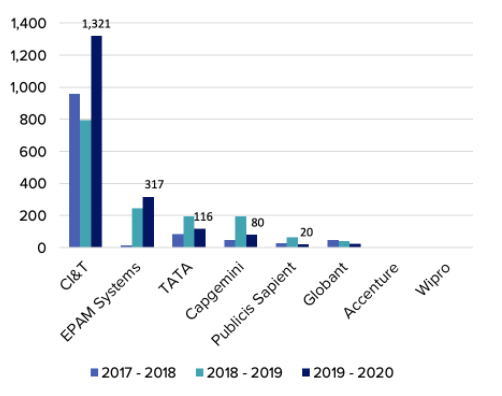Open source is gradually sliding into the workspace of most developers these days, as they prefer a model that listens to their needs, and is also something that they can exercise some control over. As opposed to closed source where only the management can change, edit, and contribute, open source welcomes all opinions - from all nooks and corners of the world.
Why open source?
In recent times, we’ve been seeing a number of big companies using open source software (OSS) in business and preferring it over the proprietary model. This shift can be attributed to multiple reasons.
Working with open source translates to minimal costs and time incurred in surveying and researching on market-needs discovery. As the software is accommodative of all the suggestions that developers make and even lists out the best contributions, open source becomes a self sustaining model with outpouring innovation. Hence, a reason why open source is good for businesses is because it consequently relies much less on its own internal resources, and is free to tap the ideas that make their way in externally.
It generally sees a greater diversity in its contributors, ranging from academic researchers to full time developers. This leads to the inclusion of a wide variety of themes and modules, and the approach becomes quality driven. This increases the market competitiveness, thus reaping long term benefits. These are the primary grounds due to which open source adoption statistics have been soaring in its favour.
But, why contribute to open source?
Multiple reasons have been identified as to why big companies that use open source find it in their best interest to contribute to it. In the diverse community of OSS users, corporations find greater innovative capability, and the relationship turns symbiotic. There exists a give and take of ideas from which the entire pool of users, companies using open source in business included, benefit from. It also becomes a passive form of CSR (Corporate Social Responsibility), as a little shared goodwill never hurt anyone.
Apart from that, being in close proximity to the market of end users acts as an innovation catalyst. A recent McKinsey report talks about this phenomenon called ‘Developer Velocity’, referring to the act of enabling developers to create an environment and a subsequent methodology where their talent is left free of any friction - which results in newer, fresher, unbound ideas.
Open source, hence, demarcates itself clearly from stagnation. Companies that use open source software don’t lose their hair worrying about going out of fashion. Every time the market undergoes a change, it is sure to be reflected in the OSS by its community. The end result is a mutually beneficial relationship, where the company stays up to date with all market fluctuations and demands, and it gets updated whenever there arises a need - becoming a repository of high utility modules. Read more about the perks of being an open source contributor here.
Impact of large companies on open source softwares
During recent times, the open source community has seen quite a bit of infiltration from big players in the market. Large companies venturing into open source is on the path to become the norm soon. These companies are some of the major vendors of open source -
- IBM has turned out to be pretty resourceful with various OSS projects, contributing to a list of platforms like Hyperledger, Kubernetes, Node.js, Egeria, etc. IBM also has a training program for OSS contributors, and goes the extra mile by sponsoring various OSS projects.
- Google broke the ice by creating Kubernetes in 2014, an open source container orchestration system that automates a bunch of manual work done in managing and scaling applications. Presently, under Google Summer Of Code and Google Code In, Google invites University and high school students respectively to intern with them by contributing to different OSS projects.
- Facebook’s most notable open source creation would be React Native, a mobile application framework - used to develop various applications for diverse platforms. Other OSS projects by Facebook include Hermes (javascript engine created to run React Native on Android), Detectron2, Hydra etc.
- LinkedIn runs a large number of OSS projects under LinkedIn Engineering - some of which are Ambry, LASER, Helix and Kafka. Apart from contributing to OSS and using OSS in business, LinkedIn also maintains a dedicated blog for the articles related to it, and a separate tab enlisting all the research work on OSS that LinkedIn community has contributed to.
- HPE and Intel are working on Network Functions Virtualisation(NFV) for 5G installations, partnering with open source platform RedHat for the same.
- Another alliance on the frontline is that of Apple, Amazon and Google - working together under the Connected Home over Internet Protocol (CHIP) project to create an all-in-one smart home device, and in the process, share and use each other’s resources.
Talk about the open source community is incomplete without the mention of GitHub, a software development platform that boasts of being the largest in the world. Microsoft’s acquisition of GitHub goes on to show that large companies are seeking to become major vendors of open source and are ready to invest large amounts of capital in the same.
Hence, in the open source platforms that we see now,
- Scalability is high - owing to cyclic contributions that not only keep the resources from stagnation but also constantly add value to it.
- Sustenance is dependent on contributions - which might be voluntary, sponsored, or both. Since its users are also its contributors, open source leads to exemplary results with minimal investment on creating and updating its own resources.
- Bug resolution is done by the users themselves. Constantly identifying errors and shortcomings keeps the site updated. Newer versions are tested, approved, and rewarded within the community.
Seeing through the eyes of Drupal Community
Dries Buytaert, founder and project lead of Drupal, in one of his personal blogs, identified that open source communities are seen to be working at a steady pace even when the world suffers from recession. A collective purpose and associated ethics are the main drivers of OSS, making it resilient to external factors.
According to one of Dries’ blogs, Who sponsors Drupal development? (2019-2020 edition), contributions to Drupal keep increasing by each passing year. The Drupal project has gained from the contributions by big companies that use open source like Capgemini and EPAM systems. Dries notes that even though the contributions from tech giants lag behind considerably when compared to the traditional Drupal businesses, he hopes to see a dramatic shift in the coming future. Apprising large enterprises about the value of contributions to large open source softwares like Drupal will go a long way. Moreover, providing better incentives can also play a huge role in increasing contributions from big companies, he feels.

Open source has been a revelation during coronavirus pandemic. The Covid-19 pandemic couldn’t put a stop on the development of the Drupal project. #DrupalCares campaign proved successful as a number of organisations and individuals helped raise $500,000 in just over 30 days. This shows that OSS is treated as a public good - something that is non-rivalrous, and can be used by and benefits everybody. Instead of racing against each other, users of open source run together, and share its responsibility.
The future of open source communities
More than a new concept, open source fits in like an upgrade to the software world. It is the beginning of a virtual workspace that is very user friendly and has the potential to achieve maximum consumer satisfaction.
Open source communities have also responded to the COVID-19 crisis with much responsibility, participating in and contributing to the COVID-19 Global Hackathon. Giants like Facebook, AWS, Twitter etc. have gone ahead and shared resources to assist the participants. Also, a number of open source collaborative projects have shown up to tackle problems that the world is dealing with right now, creating digital solutions as an effort to minimise the effects of the coronavirus pandemic.
Subscribe
Related Blogs
Trek n Tech Annual Retreat 2025: A 7-Day Workcation of OSL

OSL family came together for the Trek n Tech Annual Retreat 2025, a 7-day workcation set amidst the serene beauty of…
Exploring Drupal's Single Directory Components: A Game-Changer for Developers

Web development thrives on efficiency and organisation, and Drupal, our favourite CMS, is here to amp that up with its…
7 Quick Steps to Create API Documentation Using Postman

If you work with API , you are likely already familiar with Postman, the beloved REST Client trusted by countless…




